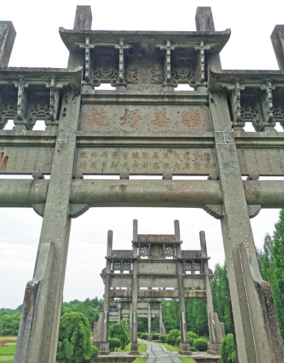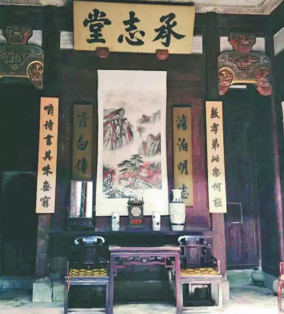Huizhou heritage comes to life
Traditional architecture in ancient villages spurs tourism and cultural pride, Wang Ru reports.

It was a natural choice for veteran Huang Yu, after serving in the army and owning a business in Hangzhou, Zhejiang province, for years, to go back to his hometown in Xidi village, Huangshan, Anhui province, in 2016. He took over the homestay his parents opened when he was a middle school student.
"I was born in 1986, the year when tourism started to develop in Xidi. I always feel proud as a local and want to make a contribution to the development of my hometown," says Huang.
In 2000, Xidi and the nearby Hongcun village were declared World Heritage sites by UNESCO for their outstanding preservation of rural architecture dating to the Ming (1368-1644) and Qing (1644-1911) dynasties.
Now, walking along the bluestone streets in Xidi or Hongcun, visitors can appreciate the distinctive Huizhou-style houses, featuring white walls, dark tiles and layered horse-head gables, and feel like they are immersed in a traditional Chinese ink painting.
This level of preservation could not be achieved without the participation of local residents. According to Huang, this awareness is not new — since all streets and alleys in Xidi are paved with bluestone, historically, street vendors carrying wares on shoulder poles were forbidden from letting their poles touch the ground in order to protect the bluestone.
A symbolic paifang, or traditional Chinese memorial arch structure, standing at the entrance to Xidi, was built in the 16th century in memory of Hu Wenguang, a Ming Dynasty official born in the village, who made a great contribution to improving people's education and livelihoods. It is preserved to this day because of people's desire to protect the local historical characteristics.
According to Huang, in the 1960s and '70s, Xidi residents made a living mainly through the production of lime. Some people proposed to burn the paifang, which is made of stone, to make lime, but most villagers opposed the idea. "Although people struggled to make a living, they still didn't want to destroy the legacy," says Huang.
Cheng Xiuli, a resident of Hongcun, says: "Preservation awareness is deeply rooted in our hearts. Our ancestors have left us a great legacy, and we must care for it well."
A local folk rhyme says: "One is not lucky to be born in Huizhou. At 13 or 14 he is kicked out of his hometown to make a living."
The rhyme hints at the struggles once endured by the people of Huizhou, a historical prefecture which straddled the border between southern Anhui province and the north of Jiangxi province and covered the area of what is today's Huangshan city.
Since it was a poor, mountainous region without good farming conditions, many local people had to migrate to other places to start businesses. Toward the end of the Ming Dynasty, a group of Huizhou merchants became eminent, trading in salt, wood and tea, and working as pawnbrokers with a reputation for morality and honesty.
When successful Huizhou merchants got old, they often went back to their hometown and built dwellings to spend their remaining years. Many of their houses are well-preserved today, especially in Xidi and Hongcun.
Dwellings with stories
Huizhou architecture, with its long tradition and great diversity, occupies an important place in Chinese architectural landscape, says Zhang Wangnan, director of the China Huizhou Culture Museum in Huangshan.
Huizhou dwellings tend to be built to conform to the natural terrain, since Huizhou is a mountainous area with few flat areas of land, according to Zhang.
Moreover, daylight is valued in Huizhou houses, which is reflected in the building of open interior courtyards, which allows sunshine to enter the rooms.
"Huizhou merchants also believed that water symbolizes wealth. When it rains, water falling on the pitched roof soon flows to the courtyard. It stands for retaining windfall profits," says Zhang.
Huizhou is famous for its stone, wood and brick carvings, which are widely used in the decoration of local dwellings. "People carve auspicious patterns and historical stories on the beams, windows and pillars of their houses. In this way, they integrate their aesthetic values and emotions into the buildings, making them more beautiful and educating their children through the meanings contained in the patterns," says Zhang.
Features of Huizhou dwellings display the characteristics of local people. "If you look at the outside of a Huizhou dwelling, it seems simple, enclosed by walls, but the insides are open and broad, with complicated decorations. It is just like Huizhou people, who are often reserved toward strangers but friendly when you get to know them," says Zhang.
Zhang says that Ming dwellings differ from those of the Qing Dynasty in many aspects, for example, having fewer horse-head gables and less complicated carvings. Remains of Ming dwellings can be seen in Chengkan village, Huangshan; those in Xidi and Hongcun are good examples of the Qing style.
Besides ancient dwellings and paifang, ancestral halls, where clans would gather to make sacrifices to their lineages, form what is considered to be the three wonders of ancient Huizhou architecture. The three types differ in style and function.
Since people in an ancient Huizhou village were organized into patriarchal clan systems closely linked by kinship, ancestral halls were the locus of public life, where clans would gather to discuss important issues, according to Zhang.
Many of the ancestral halls are now opened to the public as tourist attractions or exhibition halls. Some feature magnificent architecture and exquisite carvings, while others are small but elegant — all have high artistic value and are treasures left by ancient people, says Zhang.
Shexian county used to be the administrative center of Huizhou, where many officials settled. It still keeps many of the old paifang, which tell a number of glorious stories about the past.
"Paifang, in the old times, were often dedicated to individuals as an award for sterling qualities, like a present-day certificate awarded for role-model behavior. They witness the struggles of Huizhou people, showing their positive attitude to life and their spirit to strive for the better," says Zhou Hu, deputy director of Shexian's cultural heritage administration.
Zhang says: "Dwellings are people's personal space, ancestral halls are public space for villages or clans, and paifang praise the morality or contributions of individuals. They, together with ancient bridges, courtyards and gardens, join to constitute the profound heritage of Huizhou architecture."
Folk customs
After returning to Xidi, Huang renovated his homestay. He says the tourism boom helps to protect and breathe life into the ancient village.
"Our houses are often wooden structures with brick walls, which require a lot of maintenance," he says. "Once a vacant ancient building has its roof tiles weaken, it leads to water leakage when it rains, and the wooden structure will rot. Therefore, it's important to keep people living in these buildings in order to maintain them properly."
Tourism development has brought many people back to the village. "An old village often declines when many locals migrate to other places for work. To better protect them, we need to incentivize villagers to stay and continue contributing to local life, so that tourists can receive better service and local people can make money at home," says Huang.
Some folk customs have been retained and newly oriented toward tourism, offering glimpses into the lives of the ancient Huizhou people, for example, the sounding of the night watch in Xidi, or broadsword dancing in Xucun village, Shexian.
"These customs are revived as a demonstration for tourists, and to maintain the inheritance of traditional culture. This symbolizes the combination of intangible with tangible cultural heritage," says Zhang.
He further suggests that the old Huizhou villages explore and find their own unique, marketable themes. "Each of them should find a dominant local feature, whether it is tea, chrysanthemum or rapeseed flowers, and then make it the theme of the village, so that they can give full play to their distinctive cultural charm."
Wang Kaihao and Zhu Lixin contributed to this story.




































